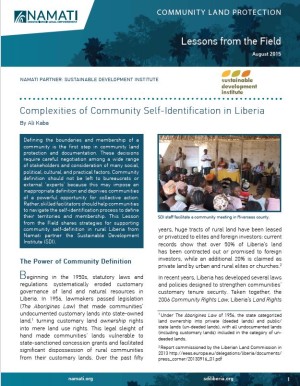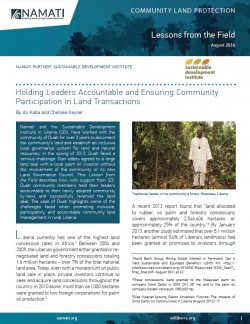Drawing on seven years of research and field-testing, Namati and our partners have designed a powerful five-part process for protecting community lands and natural resources. Our approach combines the legal and technical work of mapping and documentation with land conflict resolution and community-wide agreement on local rules for land and natural resource management. Throughout the process, we collect detailed data and observations that we analyze rigorously to continue to learn and improve our work.
Namati has found that each part of this approach is necessary to ensure successful community land protection and equitable, community-driven development and prosperity.

Download Namati Community Land Protection Process PDF
All aspects of the work should be driven by the community’s own priorities and concerns, with facilitators listening carefully and adapting the process as necessary. That said, we recommend that facilitators aim to support communities to complete the entire process in six to twelve months of weekly or bi-monthly meetings. To improve efficiency and maintain community momentum, it is often best to undertake the by-laws drafting process and the boundary harmonization process concurrently, as they both take significant time and effort to complete.
Namati champions innovation, creative adaptation, and shared learning. We encourage land rights advocates to adapt our approach as necessary to their local contexts and cultures. We encourage all organizations to share their adaptations, modifications, lessons learned, and impacts with us so that we can continue to strengthen the land protection work of Namati and our wide network of community land protection partners. Contact us at communitylandprotection@namati.org
Lessons from the Field: Complexities of Community Self-Identification in Liberia
Defining the boundaries and membership of a community is the first step in community land protection and documentation. These decisions require careful negotiation among a wide range of stakeholders and consideration of many social, political, cultural, and practical factors. Community definition should not be left to bureaucrats or external ‘experts’ ...
Lessons from the Field: ‘Visioning’ as a Foundation for Community Land Protection
Until recently, staff at the Land and Equity Movement in Uganda (LEMU), would start a community land protection process with conflict resolution. However, they found that focusing on contentious internal land disputes tended to exacerbate internal discord and even impede the community land protection process. This ...
Lessons from the Field: Customary Rules and Practices Strengthen Women’s Land Tenure in Rural Mozambique
Under Mozambique’s Constitution and Land Law (1997), communities may legally govern their lands and natural resources according to customary norms and practices, so long as local customs do not contradict national law. However, rising land scarcity and associated increases in land value are leading some families ...
Lessons from the Field: Holding Leaders Accountable in Land Transactions
Namati and the Sustainable Development Institute in Liberia (SDI), have worked with the community of Duah for over 3 years to document the community’s land and establish an inclusive local governance system for land and natural resources. In the spring of 2013, Duah faced a serious challenge: ...
Lessons from the Field: Responses to Encroachment
Community land protection efforts must often confront cases of encroachment, where individuals have claimed part of community land as their own private property. Namati and the Land and Equity Movement in Uganda (LEMU) have witnessed this in many communities in northern Uganda, where encroachment disputes often ...





